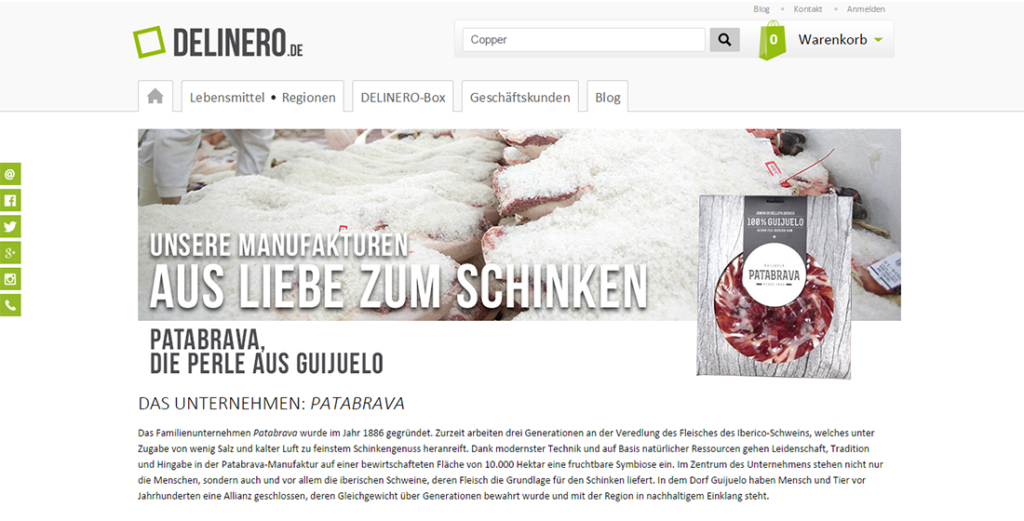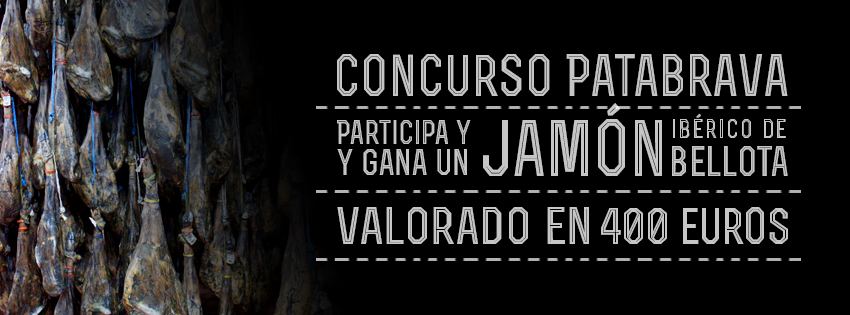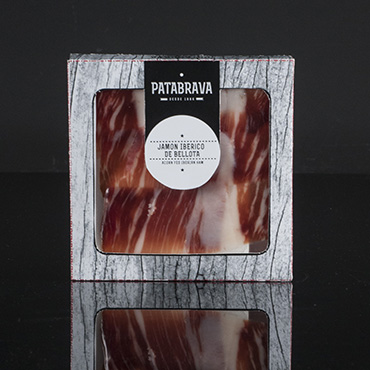Con este artículo conseguimos entrar en un país como Alemania, amante de nuestras tradiciones y productos más exclusivos.

How can we imagine your family business? How many family members work for Patabrava, and is it sometimes more complicated to work with family members than with regular employees?
Our family has been in this business since 1886. Nowadays three different generations are working together in Patabrava, because the grandfather not only is not actually retired, but also is the chief.
His decisions use to be always the proper ones, even when my brother and me have academic degree…;)
It’s easy work together, but the main reason is not just we are family.
It’s because we are focused in the same philosophy: quality, tradition and customer service.
I don’t think this is something you can learn, or explain easily to somebody, so finally it’s engaged with your education and of course, the family.
But I’m sure that if anyone of us would be working in other sector, that individual philosophy will be the same.
What does the term “tradition” mean to you?
Tradition is the start and finally the end of our work.
The start because that word gets the heritage of our ancestors.
And when your craved objetive is the excellence, in this sector there is only one form to get it: TRADITION.
Is progress important to you and if yes, how do you achieve it?
Progress is very important in our work. The hygiene and sanitary conditions in our factories, slaughter house, etc, and of course the technology to check the result of the work have been changed a lot during the last 130 years.
It’s funny to find the ultimate technology (as Isotopic analysis is, see attached file) in a “old” world as this is.
Your ham originates in Guijuelo D.O., which is a protected geographical indication. What advantages do you see in such a Denominación de Origen?
Guijuelo is not only the oldest D.O. in Spain, but also is the biggest and powerful. This is used in a one way form: raising quality standard and keep the tradition.
Guijuelo is a village that is 1000 mt high, with special climate conditions: dry and cold, and with very low but constant winds from the northwest. This allows making an Iberian ham with a very low quantity of salt. That’s very important, because we transform a big piece of meat, in a high quality product whit only two ingredients: cold and salt.
Our objetive is an Iberian ham that taste as an Iberian ham should taste; not salty. That is very important because to dry a ham sooner and ensure this meat even when the climate conditions aren’t the ideal ones, you just have to add more days wrapped under salt and you’ll get it; but the quality of the product will be directly worst.
Because of that, we are every day looking for the best way to reduce the quantity of salt, and using the nature of the climate conditions of Guijuelo.
In the same way, you could do the whole process of making an Iberian ham in a climate artificial controlled room, but the quality is lower too. The reason of that is because the long period of curing.
In a natural process, opening and closing every day and even every hour the numerous windows of our factory, the cured is done very gently. That way allows to the different areas of an Iberian ham to be cured properly, from the outside to inside in a homogeneous way.
However if you make an Iberian ham in an artificial climate way, the thinner areas of the ham, (called babilla) are suffering the power of a constant and powerful wind, too dry.
If you try to do that artificial climate process with lower winds, you’ll not get the advantages you are looking for: shorter process (financial costs), so it will not be interesting.
All this explanation is about the advantages of Guijuelo, as the best place for a natural dry curing Iberian ham.
However the main region of get the best Iberian acorn feed pigs are Extremadura, North of Andalucia, of course Salamanca in Castilla y Leon, and even west areas in Castilla la Mancha.
All these places are the most traditional and are the best DEHESA areas: the places where the bellota (the fruit of the acorn), the grass, and the open range life allow doing the best Iberian pig since the roman times, as Virgilio told us.
Guijuelo is allowed to get the best Iberian pigs from all these regions, not only the nearest ones. This is because our village was traditionally the earliest (remember PATABRAVA is since 1886) to look for a commercial way of making Iberian ham business (so we have the best professionals and experience) , and more important, to look for the excellence in a product that previously was only seen as a mere food, trying to reduce the amount of salt, increase the period of curing and homogeneity, and implement technology to assure quality for the customers.
A very important topic for our customers is how the pigs are raised. What can you tell us about their lives on the farms?
I can tell you one only think: I exchange right now my life for any of our Iberian pigs.
They live in total freedom, in wonderful and bucolic places, eating as much as they want, and doing everyday all that they want.
Iberian pigs are social and curious animals, but because of the great extensions of our Dehesas, every time we are looking for them in a dehesa, we even can’t count total animals we know they live there.
Why is the Iberian pork only fed with acorns and how does this diet affect the quality and the taste of the ham?
As you know, the bellota is the fruit of the acorn, so it’s impossible to feed just and only with bellota a pig. This is a myth.
But bellota is so important to improve quality to the ham, that usually is the commercial name to identify the best hams of the world.
The bellota is a haealthy fruit (high oleic oil levels) but there is only one animal allowed to take whole advantage and assimilate this fat to their organism: Iberian pig.
Genetically is a different pig because they convert easily this fruit in adipose and intramuscular healthy fat. There are many scientific studies that corroborate lower rates of coronary heart diseases in people who use to eat jamon iberico de bellota.
When bellota is mature, (this period is called MONTANERA and is usually from October/November to February) and start to fall, Iberian pigs eat and eat everyday even 10/12 Kg of bellotas, so they increase their weight from 90 Kg up to 190 Kg in a short period of time: three months.
When a PATABRAVA little iberian pig has born, (always in freedom, never in a farm) we try to do a thin pig until they have at least two years, in order of at that age, they are big animals but quite hungry…so they are wishing to see bellotas starting to fall.
But we are very lucky: bellota ham it is not only a healthy food but also a has unique flavor, it taste different:
Comes on strong in the mouth, with a warm and harmonious aroma reminiscent of moist acorn. Intense colour. Smooth and balanced texture.
How does the climate affect the maturation of the ham?
We are worried about climate changes. We are climate dependent in both areas: Dehesa and ham drying process.
The bellota is a fruit and dehesas are a wide area, so every year is different and we need to adapt the number of pigs we think a single area of dehesa may allow to fat a number of Iberian pigs. Experience is fundamental to do this calculation, but climate changes may force a mistake. In that case you help those pigs to eat with other cereals as wheat, barley and other natural feed, but the quality of the ham will not be the same, and the commercial name must be different from “bellota”.
Even more important is the climate conditions to do a properly natural ham drying process, so the temperature increase is a big threat to Guijuelo as you can imagine.
What is the most traditional way to consume your ham and what creates the perfect experience (wine, bread, oil, salt etc.)?
Slices should be arranged on a plate so that they overlap slightly –not too far apart, but not heaped on top of each other either. Slices should be thin and almost translucent, shiny, aromatic and juicy. A good carver will also manage to cut slices in which the typically Ibérico fat and lean are
represented: this is what gives the succulence and excellence that characterize our ham. Serve at a temperature of around 25ºC.
It may be consumed with Fino wine (this is the best way to get the flavours) , or a red one, usually a crianza may be better than a reserva one.
Sometimes reveals white specks within the meat: these appear as a result of long curing and could be said to represent a quality guarantee. Technically speaking, they are crystallizations produced by precipitation of tyrosine, an amino-acid found in meat, brought about by the difference between the extremes of temperature that occur naturally in our cellars during the long curing process undergone by PATABRAVA hams. These marks indicate positive attributes and should never be discarded.
How often do you eat ham yourself? Aren’t you sometimes tired of it, since you work with meat every day?
I use to eat Iberian ham every day of my life.
Every ham is a whole world, because it resumes a lot of work, dedication and conditions. I love to discover the details and look for the ones that I don’t expect. My father or my brother and me may have different likes, but we are in love with our Iberian ham world.
What would you tell a vegetarian, what he or she is missing?
Maybe I’m mistaken, but I think vegetarian uses to be people committed to the environment, who look for natural food and being respectful with the animals and plants life, as our ancestors did during generations.
All this definition is perfectly fulfilled by our products.
I know that they probably tell me the principal problem: we sacrifice these animals; but I assume that they trust me if I tell them our animals live and die according the same way as thousands years ago, and always strictly under E.U. laws.
We are very committed with our own animals, dehesa and this whole environment.
So Dear Vegetarian: If you have to eat any meat, try PATABRAVA Iberian pig.
What would your favorite profession be, if you wouldn’t work in the family business?
My family and me love motorsport, so I may tell you that I wish to have a profession related with that world, but if I made realistic thoughts, I’ve always the same thinking: even today we have people in the dehesa that work only with the pigs, every day. Pure nature, only with your pigs, your acorns, maybe a dog.

